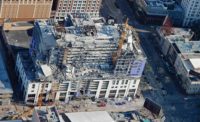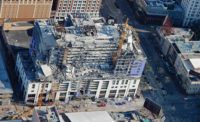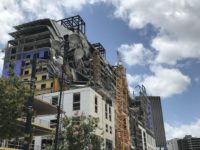Workers have recovered the remains of two construction workers whose bodies remained trapped in the rubble of the Hard Rock Hotel – nearly 10 months after the structure partially collapsed during construction.
The body of Jose Ponce Arreola, one of three men killed in the collapse, was removed from the site by an urban search and rescue team just before 4 p.m. Aug. 17, New Orleans city officials confirmed. On Aug. 8, the same search and rescue team recovered the body of the other victim, Quinnyon Wimberly.
The bodies of both men had been trapped in the rubble since Oct. 12, when the upper-floors of the 18-story building collapsed, killing three people.
The remains of Anthony Magrette, the third worker killed, was recovered two days after the collapse. Search and rescue teams were unable to reach the others until now because the structure’s instability made the effort too risky.
“It is a terrible relief to begin finally bringing this process to an end,” New Orleans Mayor LaToya Cantrell said in a written statement.
Representatives of project owner and developer 1031 Canal issued a statement saying no one was injured and no property sustained damage during the recovery operation, which has been under way for several weeks.
“1031 Canal expresses its deepest sympathies to the families and loved ones of these two good men, who have suffered for a long time waiting for the recoveries,” the statement read.
The recovery of the two bodies and subsequent demolition has been a complex mission fraught with risk and delays. Demolition work began in May with the goal of removing the two bodies and taking down the building’s upper floors by July. But weather and equipment issues further delayed the recovery, frustrating the men’s family members.
In January, the stalled recovery effort came under fire after winds blew away a red tarp that had been concealing Wimberly’s legs, which were sticking out of the building visible from the street.
For months leading up to the start of demolition, city officials and the developer were at odds over what would be the safest way to take down the partially collapsed structure. The developer pushed for a traditional, piece-by-piece demolition, while the city insisted that an implosion would be safer. At one point, city officials thought the building would have to be demolished with both bodies still inside.
Under a deadline set by a Civil District Court judge, the city and the developer reached an agreement on a piece-by-piece demolition, and the city issued a demolition permit in late April.
The demolition process began in May with crews tearing down three buildings that were in the Hard Rock’s footprint to put cranes in place. Next, they removed the remnants of the tower cranes that were brought down in a controlled demolition a few days after the collapse. In July, search and rescue workers began clearing debris so they could get to the two bodies.
Now that the bodies have been removed, workers can begin dismantling the rest of the structure – a process that could be complete sometime around the one-year anniversary of the Hard Rock collapse in October.
“At this point in the process, the contractor will shift to the demolition of the upper floors, which will be followed by demolition of the lower-level parking garage, and finally removal of all debris from the corner of Canal and Rampart (streets),” according to the statement from 1031 Canal.
Speaking on Aug. 18, Arturo Jauregui, the attorney representing the family of Jose Ponce Arreola, says the recovery will bring some closure for the family, but their ordeal is not over.
“We are thankful his family can rest,” Jauregui says. Arreola will be cremated, but Jauregui says the family will likely have to wait another two months to allow for the completion of the coroner’s report and a forensics analysis before they can receive his ashes.
Arreola started traveling to New Orleans to help with the city’s reconstruction after Hurricane Katrina and had dedicated his life to construction for nearly 15 years, Jauregui says. At the time of the collapse, he was preparing to return home to Mexico to celebrate the life of his mother on the anniversary of her passing. “He was really excited that he’d be able to go back to Mexico and celebrate with his brothers and sisters,” Jauregui says. “Now they’ll get his remains in an urn.”




